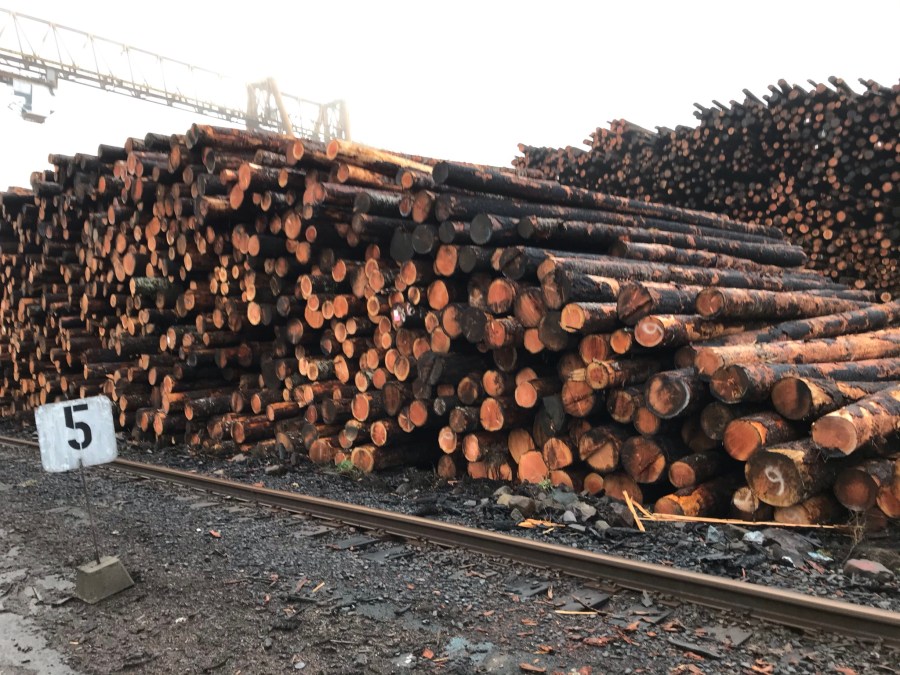PORTLAND, Ore. (KOIN) — For Oregon timber land owners whose property was damaged in the 2020 wildfires, time is ticking.
“We have five logging sites working feverishly on our company lands,” said Rob Freres, president of Freres Lumber Co., Inc. in Lyons and Mill City. He lost about 7,500 of his 17,000 acres of timberland in the 2020 fires.
Traditionally, Freres Lumber Co. cuts 10 – 12 million feet of timber per year. In the next year and a half, they’ll need to remove 75 million feet of timber from their land. A lot of their burned trees can be salvaged and the company is hoping they can still make some revenue off it.
When the Labor Day windstorm blew the Beachie Creek fire through the Santiam Canyon, Freres said his first concern was protecting his three mills. Then, the fire changed direction and pushed north, consuming his timber land near Mt. Jefferson.
Now, he, his company, and his contracted loggers are working as fast as they can to get the burned timber off the land.

“It’s been trying. It certainly has been,” Freres said. “We’ve been bringing out about 50 loads of logs every day since about the first of October and we will continue to do that all of next year.”
Even after bringing 50 loads of logs to the mill every day for the next year, Freres still isn’t fully confident they’ll be able to collect all the salvageable timber. He said he expects they’ll be able to put a big dent in it and get close to finishing their salvage operations, if not by the end of 2021, then hopefully by early 2022.
“Is there enough people to get these jobs done? The answer is no.”
After a wildfire, burned trees can lie on the ground for 18 months or sometimes longer, before insects bore their way in and make the wood unusable for lumber.
Brent Parries, co-owner of Pacific Forest Contractors, Inc., a logging company based in Eagle Creek, said he and his employees have been incredibly busy since the fires. Almost every logging company in the state has been working frantically to remove burned timber off privately owned property.
“Is there enough people to get these jobs done? The answer is no. And is there enough lumber mills to take the burned timber? Right now, the answer’s starting to become no,” Parries said.
In some places, he said the terrain is too dangerous and he won’t agree to remove the burned logs. Some areas, he said, are “burned to smithereens.” There are no strong stumps to tie their cable systems to and some areas are too rocky to dig a hole and bury a log for an anchor.
In areas with difficult terrain or areas where the timber can’t be salvaged in time, some companies might need to consider using a controlled burn on their property to clear the debris. Otherwise, they could take the chance of planting through the fallen debris, which both Parries and Freres said is not as effective for growing Douglas fir trees. They say the seedlings need full sunlight to grow as quickly and as densely as timber land owners would like.
“This fire will have a generational impact.”
For Freres, clearing the land means removing trees that he can’t make any money from. He said his trees that were 30 years old and younger that burned in the fire are a total loss. They’re too young to be used for lumber or veneer and are considered “non-merchantable.”
He said now they have a huge age gap in their trees, between ages 3 – 30 years. When the time comes when those trees were supposed to be harvested in the future, that’s when the company will face problems.

“I could foresee us not running overtime in good markets, as we have in the past, because the lack of log supply, and we’ll try our best to maintain the shifts and the employment base that we have, but there’s no guarantees, and so the future is a little cloudy,” Freres said.
He said his company’s timber land generally provides 10 – 12% of the log needs for the mills. With their own supply significantly reduced in coming years, Freres Lumber Co. might need to rely more on purchasing logs elsewhere.
Freres said selling wood chips to paper mills is another significant source of revenue for them. If their wood chips from burned timber are charred in any way, the paper mills can’t take them.
Right now, Freres runs four shifts at his two veneer plants. If finances or lumber supply become a problem in the future, he could cut that down to three or two shifts.
Despite all these oncoming challenges, Freres believes his company, which has been in business for nearly 100 years, will live on.
“This fire will have a generational impact. There’s no question. We just may have to be forced to be a smaller company, but I believe we’ll survive and we’ll be here going forward,” Freres said.
In total, the Oregon Department of Forestry estimates just under 400,000 acres of private land burned in the 2020 fires.
The Oregon Forest Practices Act requires timber land owners to replant their property within two years after a fire, if they salvage the timber. The agency says it will make some allowances to extend the deadline for land owners who can’t obtain seedlings in time. Those interested in an extension should contact ODF.